This set of VLSI Multiple Choice Questions & Answers (MCQs) focuses on “MOS Transistor Threshold Voltage”.
1. The electrical equivalent component for MOS structure is:
a) Resistor
b) Capacitor
c) Inductor
d) Switch
View Answer
Explanation: The MOS structure acts as a capacitor with a metal gate and semiconductor acting as parallel plate conductors and oxide as dielectric between them.
2. The Fermi potential is the function of:
a) Temperature
b) Doping concentration
c) Difference between Fermi level and intrinsic Fermi level
d) All of the mentioned
View Answer
Explanation: The Fermi potential, which is a function of temperature and doping, denotes the difference between the intrinsic Fermi level and the Fermi level.
3. The direction of electric field when the gate voltage is zero:
a) Metal to semiconductor
b) Semiconductor to metal
c) No electric field exists
d) None of the mentioned
View Answer
Explanation: Metal being more positive compared to semiconductor. The electric field exists from metal to semiconductor.
4. Consider a MOS structure with equilibrium Fermi potential of the doped silicon substrate is given as 0.3eV. Electron affinity of Si is 4.15eV and metal is 4.1eV. Find the built in potential of the MOS system.
a) -0.8eV
b) 0.8eV
c) 0.9eV
d) -0.9eV
View Answer
Explanation: Surface potential: qΦs = 4.15eV + 0.55eV + 0.3eV = 5.0eV
qΦm-qΦs = 4.1eV – 5.0eV = -0.9eV.
5. When gate voltage is negative for enhancement mode n-MOS, the direction of electric field will be:
a) Metal to semiconductor
b) Semiconductor to metal
c) No field exists
d) None of the mentioned
View Answer
Explanation: When gate voltage is negative, holes in substrate are attracted towards surface creating electric field from semiconductor to metal.
6. At threshold Voltage, the surface potential is:
a) – Fermi potential
b) Fermi potential
c) 2 Fermi potential
d) -2 Fermi potential
View Answer
Explanation: When surface potential reaches –fermi potential, the surface inversion occurs. The gate voltage which brings these changes is known as threshold voltage.
7. Surface inversion occurs when gate voltage is:
a) Less than zero
b) Less than threshold voltage
c) Equal to threshold voltage
d) Greater than threshold voltage
View Answer
Explanation: Surface inversion occurs when gate voltage is equal to threshold voltage.
8. The energy band diagram of the MOS system when gate voltage is zero is:
a) 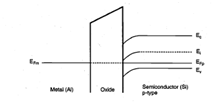
b) 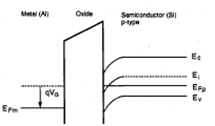
c) 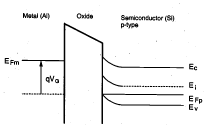
d) 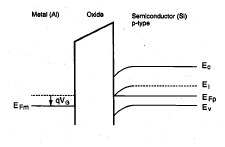
View Answer
Explanation: The energy band diagram of enhancement mode nMOSFET when gate voltage is zero is :

9. For enhancement mode n-MOSFET, the threshold voltage is:
a) Equal to 0
b) Greater than zero or Positive quantity
c) Negative voltage or lesser than zero
d) All of the mentioned
View Answer
Explanation: For enhancement mode n-MOSFET, the threshold voltage is positive quantity.
10. The threshold voltage depends on:
a) The workfunction difference between gate and channel
b) The gate voltage component to change surface potential
c) The gate voltage component to offset the depletion charge and fixed charges in gate oxide
d) All of the mentioned
View Answer
Explanation: The threshold voltage depends on: The workfunction difference between gate and channel, The gate voltage component to change surface potential, The gate voltage component to offset the depletion charge and fixed charges in gate oxide
11. The Energy band diagram of MOS system when gate voltage is equal to threshold voltage is:
a) 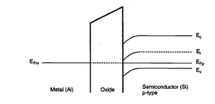
b) 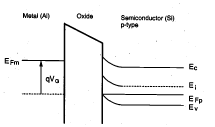
c) 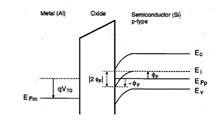
d) 
View Answer
Explanation: The Energy band diagram of MOS system when gate voltage is equal to threshold voltage is

12. The expression for threshold voltage for the enhancement mode nMOSFET is:
a) Φgc-2ϕf-Qbo/Cox-Qox/Cox
b) Φgc+ϕf-Qbo/Cox
c) Φgc-ϕf-Qbo/Cox+Qox/Cox
d) Φgc+2ϕf-Qbo/Cox-Qox/Cox
View Answer
Explanation: The expression for threshold voltage for the enhancement mode nMOSFET is Φgc-2ϕf-Qbo/Cox-Qox/Cox.
Sanfoundry Global Education & Learning Series – VLSI.
To practice all areas of VLSI, here is complete set of 1000+ Multiple Choice Questions and Answers.
If you find a mistake in question / option / answer, kindly take a screenshot and email to [email protected]
